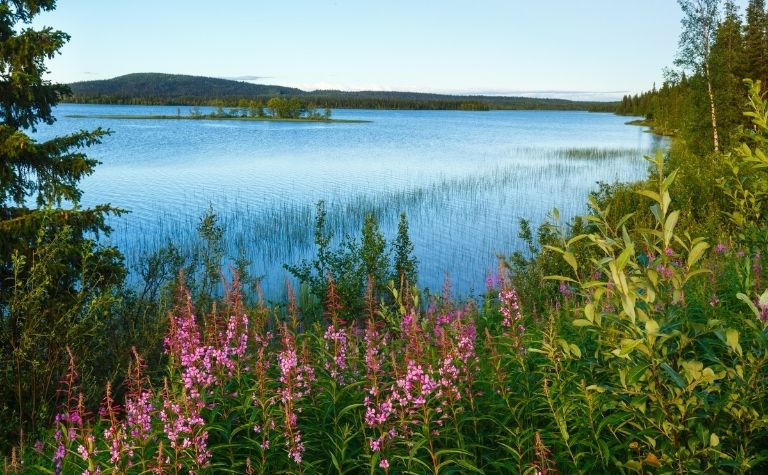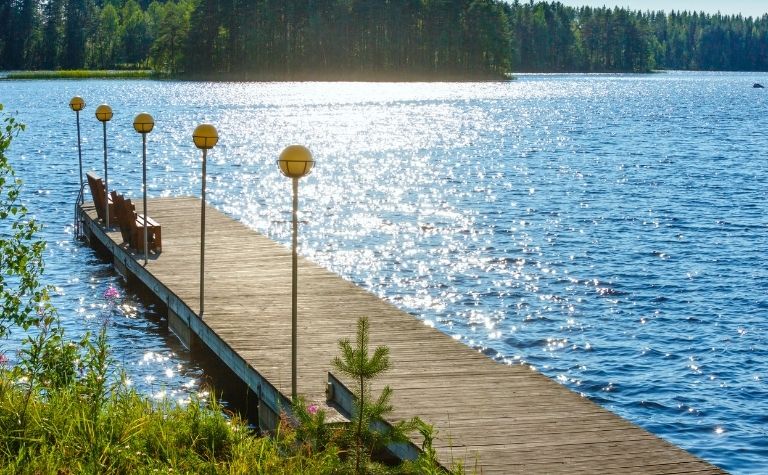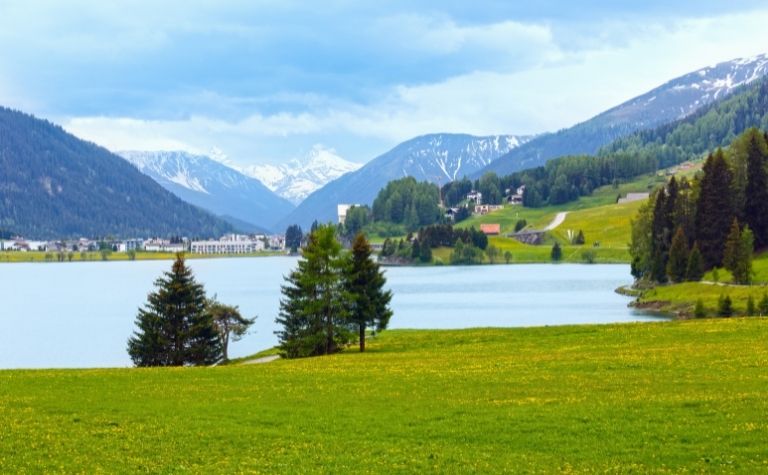Sweden, the largest country in the Scandinavian region of Northern Europe, is well endowed with numerous natural resources.
The country has more than 97,500 lakes with a surface area of more than 2 acres (8,100 m²), and among them, 22,600 have a surface area of over 10 hectares (0.1 km²). Sweden’s lakes, including Vänern and Vättern, are also part of Europe’s largest lakes.
Sweden has so many lakes due to glacial activity. According to Alfred Gabriel Narthorst, a Swedish geologist, the glacial movement led to the extensive creation of basins during the last ice age.
These depressions later filled up with melted ice to form lakes.
The rest of this article discusses Sweden’s endowment of lakes in detail.
It also touches on other areas related to this topic, including Sweden’s position on the list of countries with the highest number of lakes globally and why Scandinavian countries have so many lakes. [1]
Also see Why Do Swedish Bands Sing In English? to learn more.

Does Sweden Have the Most Lakes in the World?
Covering an area of 449,964 km² (173,732.07 mi²), Sweden is among the largest countries in Europe. The Scandinavian country also has a rich reserve of natural resources, including lush forests, mountains, islands, and lakes.
Sweden is also renowned for having the longest summer days in its North Arctic as the sun doesn’t set then.
Sweden doesn’t have the most lakes in the world. However, it takes fifth position globally on the list of countries with the highest number of lakes.
The country has 22,600 lakes that cover over 0.1 km². According to researchers from McGill University, Canada has the most lakes in the world. [2]
Canada’s lakes form 62% of the global 1.62 million lakes whose surface area is 10 hectares (0.1 km²) or more.
A scientific study on the impact of lakes on the ecosystem revealed that any climatic changes on the lakes would result in adverse climatic effects globally. [3]
The research also highlighted ten countries featuring the most lakes in the world.
Most countries having high lake densities are in the northern parts of the Northern Hemisphere.
Sweden is among the top ten nations (standing at fifth position) with the highest number of these essential water bodies.
The top four include Canada (1.62 million lakes), Russia (201,200 lakes), the USA (102,500 lakes), and China (23,800 lakes).
Although Sweden doesn’t have the most lakes globally, it has the largest number of lakes among the Scandinavian countries.
The Northern Hemisphere had an extensive cover of glaciers during the Ice Age. As the glaciers retreated at the end of the period, they caused the formation of lakes in these regions.
Therefore, countries like Russia, Canada, Sweden, and Finland have many lakes today.
Also see Why Does Sweden Have So Many Islands? to learn more.

What Are the Largest Lakes in Sweden?
Sweden’s lakes form about 9% of the country’s total area. Moreover, all the lakes in the country occupy a total surface area of 40,000 km² (4 million ha).
However, only 22 Swedish lakes cover more than 100 km² (10,000 ha). On the other hand, 358 occupy 10 to 100 km² (1,000–10,000 ha) and 3,990 cover 1 to 10km² (100–1,000 ha).
The largest lakes in Sweden are Vänern, Mälaren, Hjälmaren, and Storsjön. Vänern ranks first, covering an area of 5,519 km² (2,130.89 m²).
Vättern is 1,886 km²/728.18 m²), Mälaren is 1,090 km²/420.85 m², Hjälmaren is 477 km²/184.17 m², and Storsjön is 456 km²/176.06 m².
Vänern, the largest lake in Sweden, also takes the first and third positions on the list of the largest lakes in the European Union and Europe.
The magnificent lake extends to three Swedish provinces, including Dalsland, Värmland, and Västergötland. Vänern is vital in the country’s transport and fishing sectors.
Situated in the country’s south-central region, Vättern is the second largest lake in Sweden and the sixth largest lake in Europe.
Mälaren, the third largest lake in Sweden, is located in Svealand. While Vättern is a fishing hub, Mälaren is renowned for having two islands as part of UNESCO’s World Heritage Sites.
Vänern also takes the lead on the lake with the largest volume of water in Sweden (153 km³). Other Swedish lakes with large volumes are as follows:
- Vättern (77.6 km³ or 18.61 m³)
- Torneträsk (17.1 km³ or 4.10 m³)
- Mälaren (14.3 km³ or 3.43 m³)
- Hornavan (11.9 km³ or 2.85 m³)
- Siljan (8.09 km³ or 1.94 m³)
- Storsjön (8.02 km³ or 1.92 m³)
- Kallsjön (6.14 km³ or 1.47 m³)
- Akkajaure (5.9 km³ or 1.41 m³)
- Virihaure (4.43 km³ or 1.06 m³)
- Storuman (4.18 km³ or 1.002 m³)
Also see Why Do Swedes Have Blonde Hair? to learn more.

Why Do Scandinavian Countries Have So Many Lakes?
Scandinavian countries include Sweden, Norway, and Denmark. The three countries occupy the Northern part of Europe in the Scandinavian Peninsula.
One of the most striking features of countries in this region is their abundance of large lakes.
Scandinavian countries have so many lakes as they lie near the Arctic Circle. The region experienced glaciation (glacial erosion) during the last Ice Age, causing the creation of these lakes.
Glaciers moved along the landscape and formed depressions that later filled with water as the ice melted.
Since Scandinavian countries are near the Arctic Circle, they usually have extreme winters. So, they’re part of the earth’s regions that have heavy snow and ice deposits.
Moreover, these countries experienced the ice age (the last glacial period) about 10,000 years ago.
During the glacial era, glaciers started moving and carving out pits as they hovered on the land. After this period elapsed, the ice in these hollow areas started melting and formed glacial lakes.
Hence, Scandinavian countries, especially Sweden, have numerous lakes and moraines (accumulated debris or glacial till) resulting from this glacier activity.
Among the Scandinavian countries, Sweden has the largest number of lakes. Norway takes the second position with 65,000 lakes with a surface area above 8,100 m² (20,978.9 km²).
Denmark is the third on the list as it has smaller lakes, with 120,000 of them having a surface area above 100 m² (258.99 km²).
Conclusion
Sweden has many lakes as part of the Scandinavian Peninsula that experienced glacier activity during the last ice age. The lakes formed are glacial lakes.
Also see Why Does Sweden Have So Many Billionaires? to learn more.
